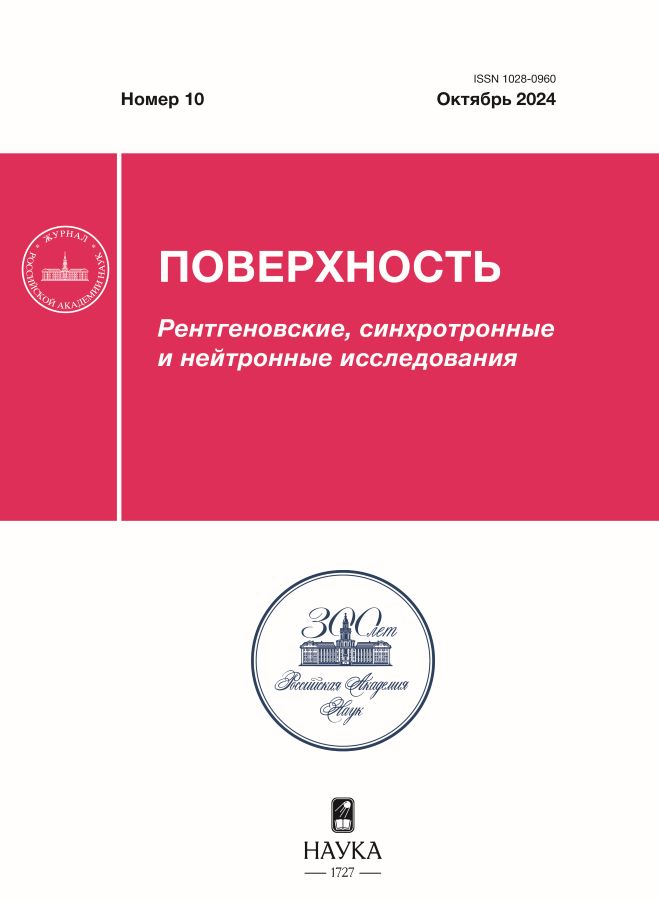Features of ohmic contact with an ion-induced p-GaAs nanolayer
- Autores: Mikoushkin V.М.1, Markova Е.А.1, Novikov D.А.1
-
Afiliações:
- Ioffe Institute
- Edição: Nº 10 (2024)
- Páginas: 17-23
- Seção: Articles
- URL: https://hum-ecol.ru/1028-0960/article/view/664729
- DOI: https://doi.org/10.31857/S1028096024100036
- EDN: https://elibrary.ru/SHPRXP
- ID: 664729
Citar
Texto integral
Resumo
The properties of a metal contact with a p-GaAs layer ~8 nm thick induced by low-energy Ar+ ions on an n-GaAs wafer as a result of the conduction tipe type conversion have been studied. The metal was deposited according to the standard technology on the surface of the semiconductor p-GaAs with a natural oxide layer, partially restored when the sample was transferred to a deposition setup. To prevent metallization of the nanolayer, the contact was not annealed. Therefore, a Schottky barrier emerged at the interface and a residual oxide layer retained. However, current-voltage characteristics showed that the formed contact is predominantly ohmic. It has been found that a high concentration of ion-induced defects radically reduces the width of the Schottky barrier and ensures the tunneling of holes and electrons of the semiconductor valence band through the barrier in the forward and reverse directions, respectively. It is shown that ion bombardment of the p-GaAs semiconductor surface makes it possible to obtain an ohmic contact with any metal without annealing. It is concluded that the ion-stimulated modification of the semiconductor and the exclusion of annealing make it possible to obtain a tunnel ohmic contact with an extremely thin p-GaAs nanolayer coated with a residual layer of natural oxide.
Texto integral
Sobre autores
V. Mikoushkin
Ioffe Institute
Autor responsável pela correspondência
Email: V.Mikoushkin@mail.ioffe.ru
Rússia, St. Petersburg
Е. Markova
Ioffe Institute
Email: V.Mikoushkin@mail.ioffe.ru
Rússia, St. Petersburg
D. Novikov
Ioffe Institute
Email: V.Mikoushkin@mail.ioffe.ru
Rússia, St. Petersburg
Bibliografia
- Baca A.G., Ashby C.I.H. Ohmic contacts. // Fabrication of GaAs Devices. London, UK: IET, 2005. P. 179.
- Blank T.V., Gol’dberg Yu.A. // Semiconductors. 2007. V. 41. P. 1263. https://doi.org/10.1134/S1063782607110012
- Mikoushkin V.M., Bryzgalov V.V., Nikonov S.Yu., Solonitsyna A.P., Marchenko D.E. // EPL. 2018. V. 122. P. 27002. https://doi.org/10.1209/0295-5075/122/27002
- Mikoushkin V.M., Makarevskaya E.A., Brzhezinskaya M. // Appl. Surf. Sci. 2021. V. 539. P. 148273. https://doi.org/10.1016/j.apsusc.2020.148273
- Mikoushkin V.M., Makarevskaya E.A., Marchenko D.E. // Appl. Surf. Sci. 2022. V. 577. P. 151909. https://doi.org/10.1016/j.apsusc.2021.151909
- Макаревская Е.А., Новиков Д.А., Микушкин В.М., Калиновский В.С., Контрош Е.В., Толкачев И.А., Прудченко К.К. // Поверхность: Рентген. синхротр. и нейтрон. исслед. 2022. Т. 10. С. 81. https://doi.org/10.31857/S1028096022100107
- Surdu-Bob C.C., Saied S.O., Sullivan J.L. // Appl. Surf. Sci. 2001. V. 183. P. 126. https://doi.org/10.1016/S0169-4332(01)00583-9
- Feng L., Zhang L., Liu H., Gao X., Miao Z., Cheng H.C., Wang L., Niu S. Characterization study of native oxides on GaAs(100) surface by XPS. // Proc. SPIE. Fifth International Symposium on Photoelectronic Detection and Imaging, Beijing, China. 2013. V. 8912. P. 89120N. https://doi.org/10.1117/12.2033679
- Mikoushkin V.M., Bryzgalov V.V., Makarevskaya E.A., Solonitsyna A.P., Marchenko D.E. // Semiconductors. 2018. V. 52. P. 2057. https://doi.org/10.1134/S1063782618160194
- Малевская А.В., Калиновский В.С., Ильинская Н.Д., Малевский Д.А., Контрош Е.В., Шварц М.З., Андреев В.М. // ЖТФ. 2018. Т. 88. Р. 1211. https://doi.org/10.21883/JTF.2018.08.46311.2591
- Haynes W.M. // CRC Handbook of Chemistry and Physics. 95th ed. London: CRC Press, Taylor & Francis, Boca Raton, 2014. 2704 p. https://doi.org/10.1201/b17118
- Ziegler J.F., Manoyan J.M. // Nucl. Instr. Meth. B. 1988. V. 35. P. 215. https://doi.org/10.1016/0168-583X(88)90273-X
- Streetman B.G., Banerjee S.K. Junctions. // Solid State Electronic Devices. 6th ed., Upper Saddle River, New York: Prentice-Hall, 2006. P. 154.
- Swaminathan V. // Bull. Mater. Sci. 1982. V. 4. P. 403. https://doi.org/10.1007/BF02748739
- Puska M.J. // J. Phys.: Condens. Matter. 1989. V. 1. P. 7347. https://doi.org/10.1088/0953-8984/1/40/010.
- Kuriyama K., Yokoyama K., Tomizawa K., Takeuchi T., Takahashi H. // Appl. Phys. Lett. 1992. V. P. 843. https://doi.org/10.1063/1.107763
- Hurle D.T.J. // J. Appl. Phys. 2010. V. 107. P. 121301. https://doi.org/10.1063/1.3386412
- Соболев Н.А., Бер Б.Я., Казанцев Д.Ю., Калядин А.Е., Карабешкин К.В., Микушкин В.М., Сахаров В.И., Серенков И.Т., Шек Е.И., Шерстнев Е.В., Шмидт Н.М. // Письма ЖТФ. 2018. Т. 44. С. 44. https://doi.org/10.21883/PJTF.2018.13.46326.17139
- Kittel C. // Introduction to solid state physics (8th ed.). New Jersey: Wiley, 2013. P. 680. https://kittel.pdf (elte.hu)
- Sze S.M. Physics of semiconductor devices. New York: John Wiley&Sons. 1981. P. 815. https://doi.org/10.1002/0470068329
Arquivos suplementares













